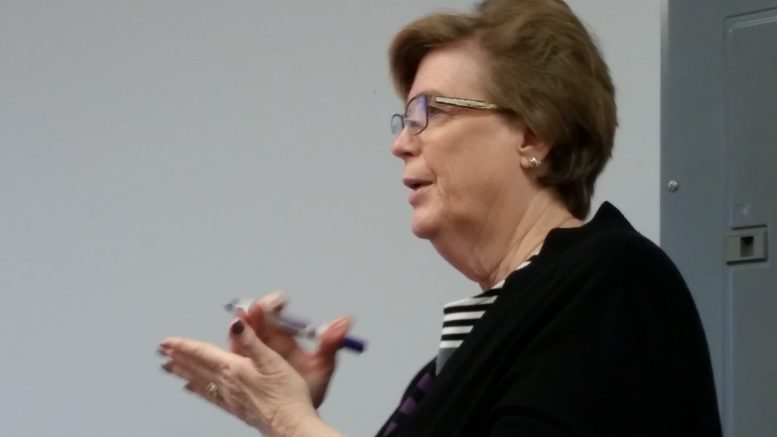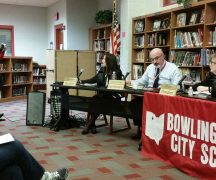By JAN LARSON McLAUGHLIN
BG Independent News
The Bowling Green Board of Education was told Tuesday that the wounds from the last election haven’t healed. So rubbing salt in them by putting the same issue on the May ballot was not wise.
Tuesday was intended to be a workshop for the school board to come up with levy strategies. Instead it turned into an opportunity for citizens to tell the board they need to listen to their voters.
“The public just told you, ‘No,’” Richard Strow said. “Seriously. They looked you right in the eye and said, ‘No.’”
“Show the public you aren’t tone deaf to them,” Strow said, suggesting the board slow down and look at other options.
But the board and Superintendent Francis Scruci said they have to look in the eyes of students, who are still in crowded classrooms, still using modular units, still have inadequate heat and air conditioning, still lack technological advancements, and still don’t benefit from collaborative teaching.
“We understand your frustration,” Scruci said to those in the audience who will be most affected by a property tax increase. But he defended the board’s decision. “We are convinced this is not only a good thing for kids, but it brings back benefits to the district. Their decision making is based on what is right for kids.”
The board voted earlier this month to put a 5.7-mill levy on the May 8 ballot for bonds just under $72 million, spread over 37 years. The bonds would pay for construction of one consolidated elementary school, plus renovations and an expansion to the high school. Due to increased property valuations, the levy would cost the owner of a $100,000 house $199 annually, rather than the $210 last time it was on the ballot.

School board at Tuesday’s meeting
“All of us are convinced there is a need,” new board member Norm Geer said. “This is the only way to do it. In order to build the buildings, we need to have a bond levy.”
Board member Ginny Stewart said she was just in one of the schools Tuesday afternoon, and the classroom was sweltering due to ongoing heating problems. She estimated that 90 percent of the district voters haven’t been into the aging schools for many years – or ever.
“Once you go into our schools, you will see what the need is,” Stewart said.
But one of the biggest objections from those speaking up against the levy was the lack of transparency by the board. Board member Paul Walker pointed out the number of public meetings that Scruci held in the months prior to the November levy.
Steve Bateson said that kind of discussion “would have been great” prior to the board voting to put the levy back on in May. That meeting was held at 7:30 a.m. And Tuesday’s meeting was held at 5 p.m. The board was accused of taking action on the levy in the “dead of the night.”
“I totally think it was not broadcast enough,” Bud Henschen said. “This community needs a cooling off period.”
Walker defended the decision. “We didn’t take this lightly. We started this project two years ago.”
But monthly public meetings that start at 5 p.m. are just not accessible to many people, Strow said.
“For me to come to your meetings, I have to leave work early,” he said. “You are in the process of making important decisions. You represent the public. You are responsible to the taxpayers.”
The board sat quietly and listened to most of the concerns until Strow continued his criticism of the board’s meeting times and lack of notice on the district’s website. “You guys should be ashamed of yourselves for that.”
Board member Bill Clifford said he was disappointed that the discourse lacked a “sense of civility.”
“We have never, ever scheduled a meeting so we would not have people here,” Stewart said. She went on to ask some of those present about their absence throughout the levy discussion process.
“Where were you for almost 18 months while we were planning all this,” she asked.
Stewart turned to Richard Chamberlain, who came out strongly against the levy before the November election. “You waited to the last minute, so you could assault us,” she said.
This time around, Chamberlain has attended every regular board meeting since the November election. He asked why the school levy was not on the agenda at any of the regular meetings. “I would have thought it would have been important enough for you people to bring up,” he said.
Scruci noted that the final item on every board meeting agenda asks for public input. “You sat through three meetings and didn’t say a word,” the superintendent said to Chamberlain.
Though many of the citizens in the audience were the loudest voices opposing the levy last time around, Bateson explained that he could no longer sit on the sidelines.
“I kept my mouth shut and I was going to live with the results,” Bateson said. But then the school board decided to try the same issue again on the May ballot.
“This was a resounding defeat,” Bateson said of the November loss. “Your board has taken ownership of dividing this community.”
Bowling Green district voters cannot afford schools like those in the Perrysburg and Anthony Wayne districts, he said. The average annual income in the BG district is $50,713, compared to $94,352 in Anthony Wayne and $90,466 in Perrysburg. Adding to the inequity is the fact that much of the BG district are renters, and much of the property tax revenues are dependent on local farmers, Bateson said.
The state formulas determining district wealth puts Bowling Green at a great disadvantage, Scruci said. The state ranking puts Bowling Green as a wealthier district than Perrysburg – because of the false readings from agricultural land and the college population.
“There is a lot of poverty in this district,” Scruci said. But that doesn’t show up in the state’s calculations.
Scruci said he didn’t view the November levy loss as a “resounding defeat.” The issue lost by 550, but the voter turnout was very low – especially in the city, where 25 percent of the registered voters cast ballots, compared to in the rural areas, where nearly 47 percent voted.
Though Scruci and the board tried to get the word out about the need for the levy, many voters believed that the district had turned down state money for building construction.
“We were never offered any state money,” Scruci said. The earliest Bowling Green would be eligible for state money is five years. State officials said they would come up to answer questions of local citizens.
Knowing the district did not turn away state money may convince some to change their votes, he said. “We thought we messaged it well, but I don’t think we did,” Scruci said.
Later in the meeting, Scruci said he wouldn’t support a third try for the same amount if the May levy does not succeed.
“I can’t speak for the board, but if it fails in May, I wouldn’t be apt to bring it back,” he said.
Bateson questioned the length of the bond issue – at 37 years. “I think there’s a great deal of concern about this level of debt,” he said. And he voiced concern about teaching contracts coming up – suggesting the district focus more on paying to keep quality educators.
“We’ve got to keep great teachers, or we’ve got nothing,” he said.
Part of the problem is that school building construction cannot be funded by income taxes.
“Property tax is the only avenue we could us,” Clifford said.
This was the one issue that both sides of the levy can agree on – blaming the state legislature not finding a solution to the school funding issue – despite an Ohio Supreme Court order to do so more than 20 years ago.
“Until they fix it, we are forced to come back in a limited number of ways,” Scruci said. “We have been talking with them, and nothing’s changed for 20 years.”
Chamberlain asked if the school district could use income tax for more operating costs, leaving property tax revenue for the buildings. Raising the income tax would be more fair to farmers and rural residents, he said.
Vicki Venn told the board the levy is just too high. “I personally can’t afford this bond,” she said. “This lavish campus that you guys want to build is a money thing for me.”
Venn suggested that the board offer two options on the fall ballot – one for the “lavish” plan and another for a “dialed down” version.
Scruci objected to the “lavish” label. The proposed consolidated elementary would be a similar style to the no-frills middle school. “These are going to be functional buildings,” he said.
The board tried to find ways to cut building costs, but did not want to cut back on the number of classrooms. The district currently has 10 to 11 classrooms per grade level. In preparation for conservative growth, the plan calls for 12 classrooms per grade level. To not plan for some limited growth would be irresponsible, Scruci said.
Some students at Conneaut are currently using modular classrooms, and two classrooms at Crim have been crammed into a divided library.
Venn said she was not supportive of a consolidated elementary. Lori Young explained the benefits of having all the students together, to limit the labeling that now occurs. Scruci talked about consolidation giving all the students access to the same resources, where no kids will be from “the wrong side of the tracks.”
But Venn said she prefers the community elementaries, where she feels her children are safe, and where they aren’t competing with “rich kids” on the latest fashions.
By consolidating the elementaries, the district would then have room to serve special needs students, such as those with autism. Outsourcing those services currently costs the district $500,000 a year. In addition to that savings, Scruci said the district would realize savings in busing costs, plus in rental costs since the administration offices would move to Crim. Expanded preschool offerings would also be made available at Crim.
Chamberlain was critical of the district competing with private preschools. But Scruci explained that the district is required by law to provide preschool for children who are identified as having some special needs. And a parent added that private preschools don’t offer the same level of services needed.





